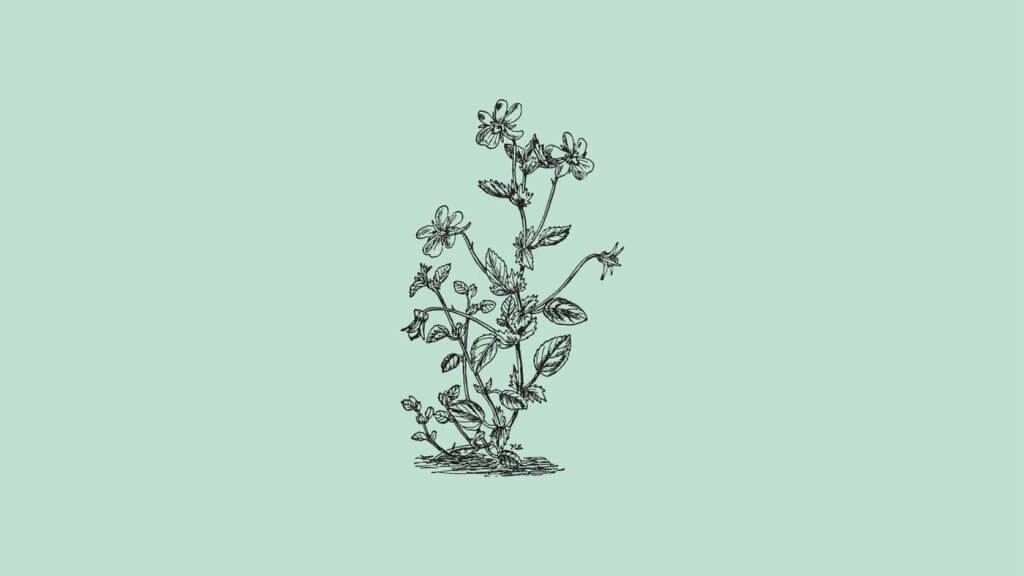Viola sororia, often referred to as the common blue violet, hooded violet, meadow violet, wood violet, woolly blue violet and simply wild violet, is a herbaceous perennial wildflower plant with a short stem, native to eastern North America. The common blue violet flowers and leaves can be eaten cooked or raw.
Common blue violets are both edible and medicinal and come up in the late winter or early spring.
Pertaining to the Violaceae family, common blue violets are both edible and medicinal and come up in the late winter or early spring.
There are several types of common blue violets, including the confederate violet known for its unique bicolor flowers, the white-flowered common blue violet, and the viola sororia freckles variety.
What Are You Foraging For Right Now?
We're thrilled to hear your ideas. What would you like to submit today? Feel free to share your thoughts and experiences with us.
Foraging wild violets is easy as they tend to grow almost everywhere and are simple to spot.
What color is the common blue violet?
The color varies. Despite its name, the common blue violet can actually exhibit a range of colors, not just blue.
The flowers of this species can be found in shades of blue, violet, purple, and even white. So, while the name suggests a specific color, you might encounter common blue violets in a variety of hues within the blue-violet-purple-white spectrum.
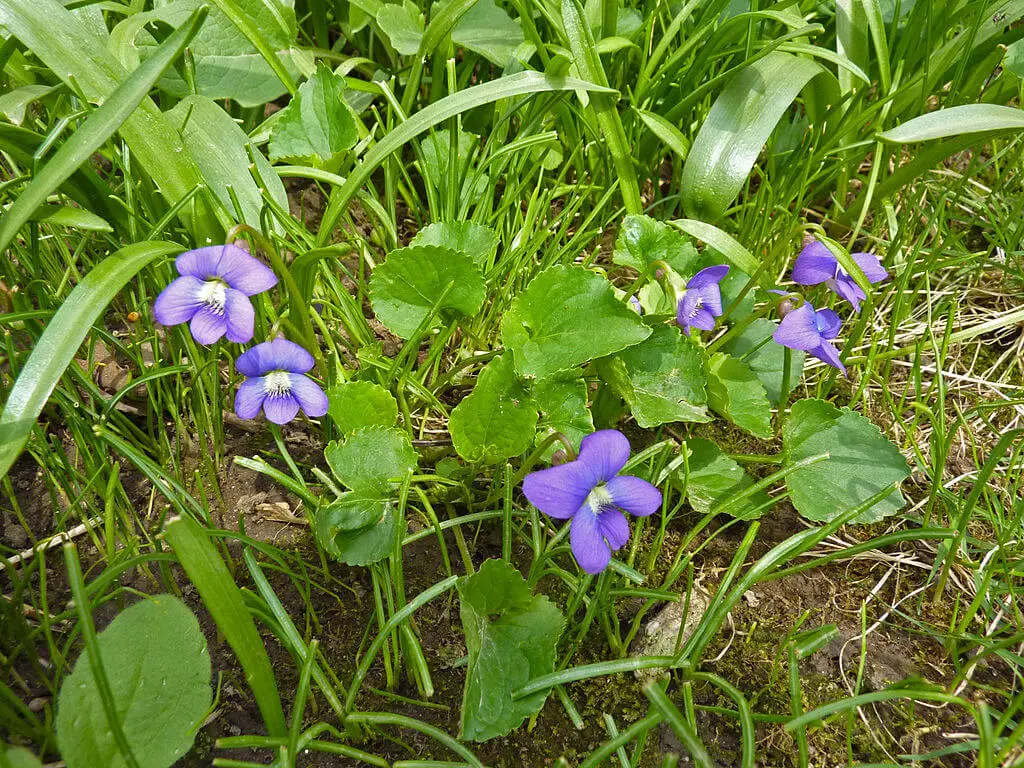
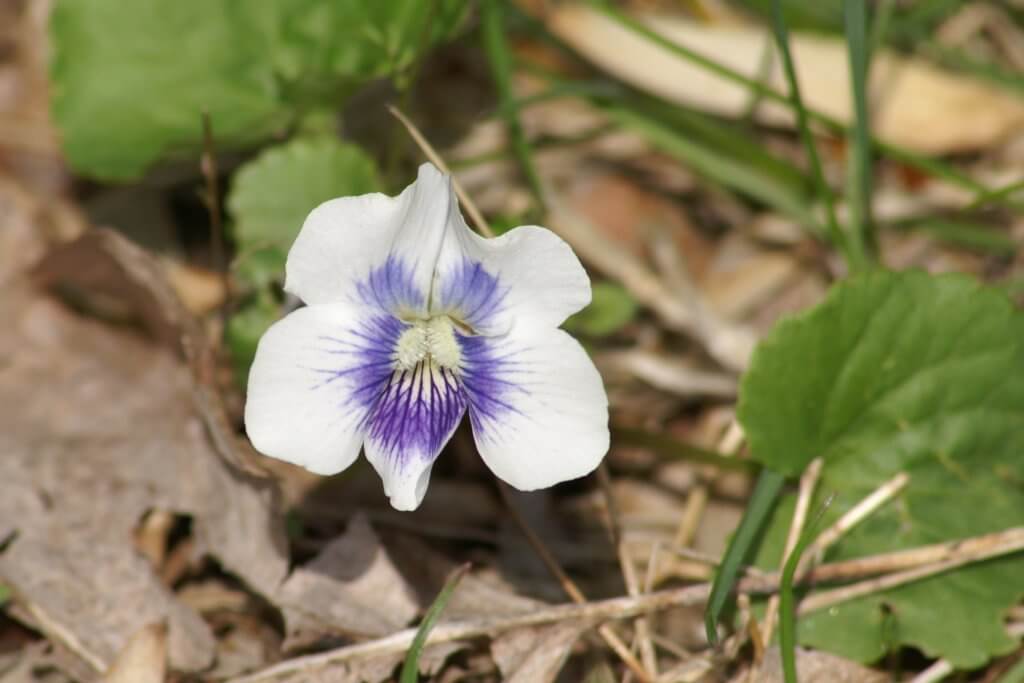

How to identify Viola Sororia?
1. Leaves:
- Common blue violet leaves are heart-shaped or ovate with rounded tips. They often have a slightly serrated or scalloped edge.
- The leaves arise from the base of the plant and are typically on long stalks (petioles).
2. Flowers:
- The flowers can range in color from blue and violet to purple and white.
- Each flower has five petals, with the lower petal having a characteristic “beard” of fine lines or hairs that guide insects to the nectar.
3. Flower Shape:
- The flowers have a distinctive shape with two upper petals, two lateral petals, and one lower petal.
4. Leaf Arrangement:
- The leaves are usually arranged in a rosette or basal cluster, emerging directly from the ground.
5. Growing Habitat:
- Common blue violets can be found in a variety of habitats, including woodlands, meadows, open areas, and even in gardens and lawns.
6. Bloom Time:
- They typically bloom in the spring, often from April to June, depending on the region and local climate.
7. Size:
- Common blue violets can vary in size, but they are generally small plants, with the leaves and flowers usually not exceeding a few inches in height.
8. Fragrance:
- Some common blue violet flowers may have a pleasant, subtle fragrance.

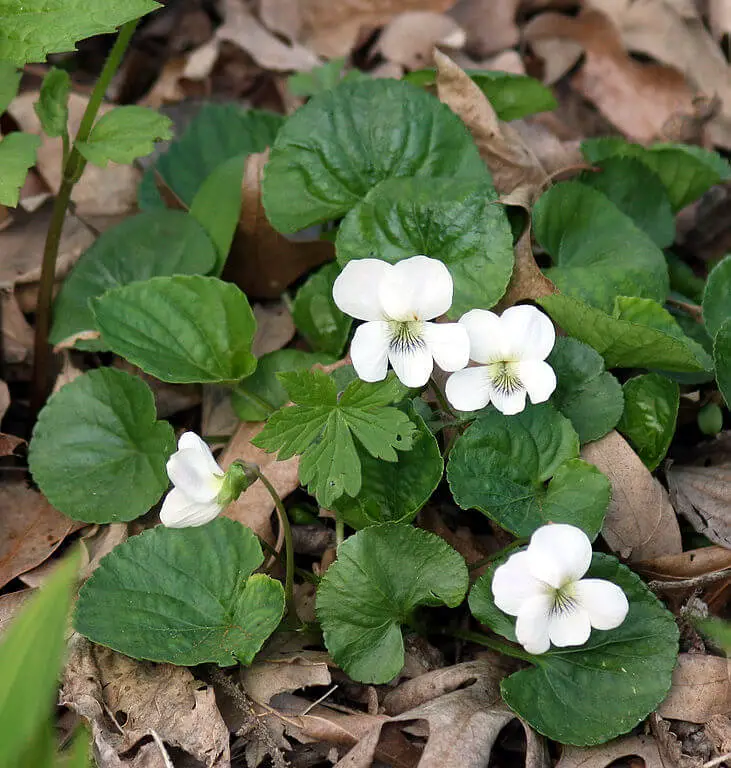
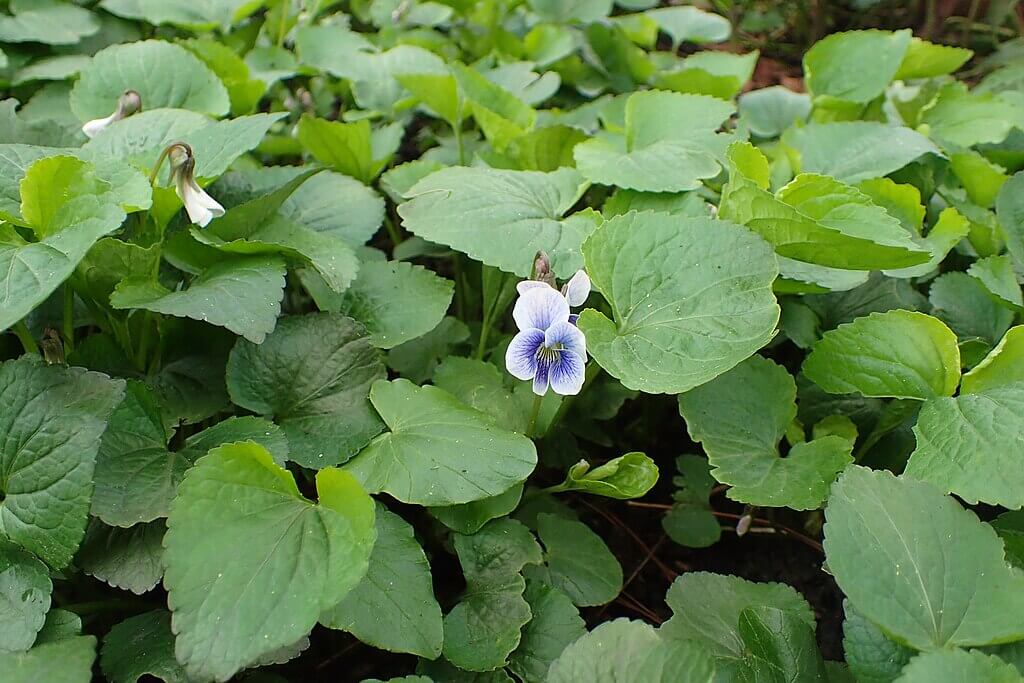
Is V. Sororia edible?
Yes, common blue violet leaves and flowers are edible and have been used in culinary applications such as salads, teas, and garnishes.
However, as with any wild plant, it’s important to follow proper identification and harvesting practices before consuming it.
Can common blue violets be eaten raw?
Violet flowers can be eaten either candied or raw. The leaves can also be eaten raw as an ingredient in a salad or can be cooked similarly to spinach.
When dried, the leaves are often used to make teas as well.
What Do Common Blue Violets Taste Like?
Common blue violets have a mild and delicate flavor. The leaves and flowers are often described as having a slightly sweet and grassy taste.
Some people also note a subtle floral undertone to their flavor. The taste is not overpowering, making them a versatile addition to both sweet and savory dishes.
How do you prepare and eat violets?
The edible violet plant can be used to make syrups, brew teas, and incorporated into baked desserts. Also, flowers can be added to salads and soups as a garnish.
Here’s how you can prepare and eat them:
- Salads: Add the young, tender leaves and flowers to salads. They can provide color, texture, and a mild, slightly sweet flavor to your dishes. Be mindful not to use large quantities, as their flavor can be subtle.
- Garnishes: Use the small flowers as garnishes for various dishes. They can add a pop of color and an elegant touch to both sweet and savory dishes.
- Teas: Common blue violet leaves can be used to make herbal teas. Simply steep the leaves in hot water for a few minutes, strain, and enjoy. You can experiment by mixing them with other herbs for added flavor.
- Candied Violets: If you’re feeling creative, you can candy the flowers to create edible decorations for desserts. To candy violets, lightly beat an egg white, brush it onto the flowers, then sprinkle them with fine sugar. Allow them to dry before using them as decorations.
- Frozen Cubes: Freeze violets in ice cubes to add a unique touch to drinks. Place individual violet flowers or petals in each compartment of an ice cube tray, fill with water, and freeze.
- Violet Syrup: You can make a flower-infused syrup by steeping the flowers in a simple syrup (equal parts sugar and water) until the flavor is infused. Strain out the flowers and use the syrup to flavor beverages, desserts, or pancakes.
- Violet Jelly: Bring 4 cups of water to a boil. Add 2 cups of violet flowers to the boiling water and let them steep for about 10-15 minutes. Strain the infused liquid to remove the flowers. In a clean saucepan, combine the violet infusion, lemon juice, and fruit pectin. Stir well. Once the mixture is boiling, add the granulated sugar. Cook until the jelly should reach the desired consistency.

Are there any poisonous violets?
Yes, there are some violets that are toxic and should not be consumed. One example is the dog violet (Viola riviniana), which contains compounds that can be toxic if ingested in large quantities.
While the dog violet is not typically lethal, consuming it in large amounts could lead to discomfort or digestive issues.
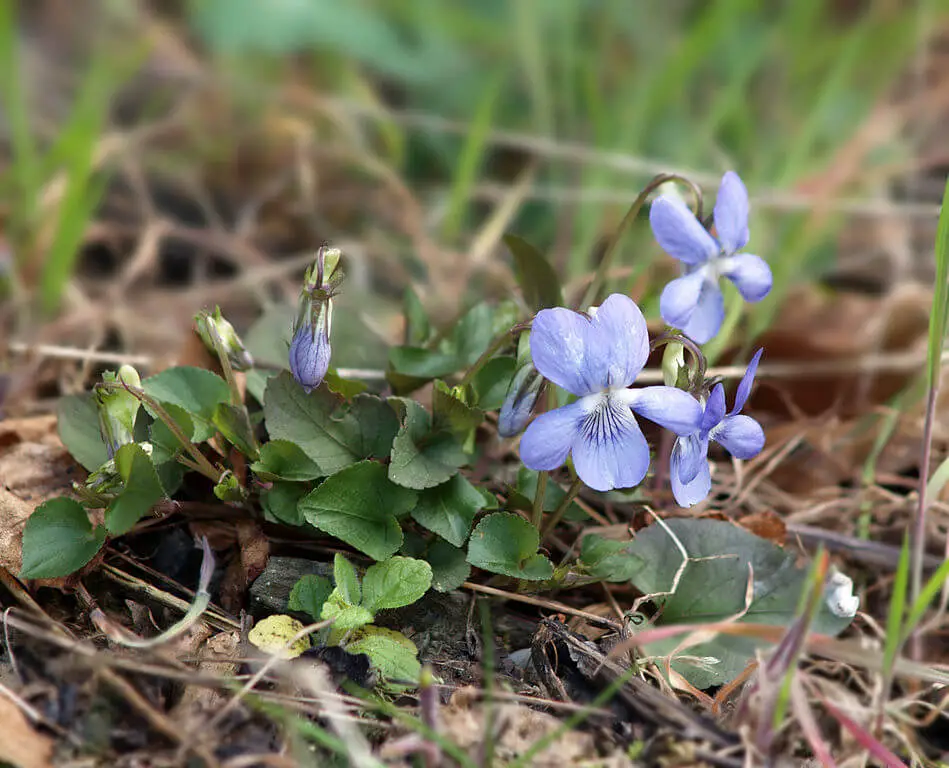
What about common blue violet look-Alikes?
There are some plants that may resemble violets but are toxic and should be avoided. One common example is the autumn crocus (Colchicum autumnale), which can sometimes be mistaken for violets due to its similar appearance. However, the autumn crocus is highly toxic and contains compounds that can cause severe gastrointestinal and neurological symptoms if ingested.
Another example is the lords-and-ladies (Arum maculatum), also known as wild arum or cuckoo-pint. This plant has arrowhead-shaped leaves and a hood-like structure called a spathe surrounding a spike called a spadix. It can sometimes be confused with violets, but it is toxic and can cause irritation if handled or ingested.


What is common blue violet’s natural habitat?
The common blue violet is native to eastern North America and is found throughout a wide range of the United States.
It is a common wildflower that can be found in various habitats, including woodlands, meadows, open areas, and along roadsides. The common blue violet is known for its ability to adapt to a range of growing conditions, which contributes to its widespread distribution.
Specifically, the common blue violet can be found in states such as:
- Eastern and Midwestern states like New York, Rhode Island, New Jersey, Pennsylvania, Ohio, Illinois, Indiana, and Michigan.
- Southern states like Virginia, North Carolina, Tennessee, Florida, and Georgia.
- States in the Great Lakes region, including Wisconsin and Minnesota.
- As far west as Oklahoma and Texas.
Is common blue violet invasive?
While it is a native plant in eastern North America, it can become invasive in areas where it doesn’t naturally occur and where it may outcompete native plant species.
Is common blue violet A good ground cover?
Yes, common blue violet can be a good ground cover option. Its ability to spread and form dense patches makes it suitable for filling in bare areas and providing ground cover in various garden settings.
However, when using common blue violets as a ground cover, it’s essential to monitor their growth and prevent them from spreading into unwanted areas.
What are the growing conditions for common blue violets?
- Common blue violets can spread through both seeds and runners (stolons). They self-seed readily, and their runners help them establish new plants.
- They can tolerate a range of light conditions, from full sun to partial shade. They often prefer dappled shade or filtered sunlight.
- They grow well in moist, well-draining soil. However, they are also adaptable to different soil types, including loam, clay, and sandy soils.
- While common blue violets prefer consistently moist soil, they can tolerate periods of dryness once established.
- They generally prefer neutral to slightly acidic soil, with a pH range of 6.0 to 7.0.
- They can tolerate cold temperatures but may benefit from protection in extremely harsh winters.
Are blue violets perennials?
Yes, common blue violets are perennials. This means that they live for more than two years, with their growth and flowering cycle repeating each year.
What to read next: Are Lilacs Edible?
Ana has always been interested in all things nature and flora. With her expertise in home gardening and interest in foraging, she has been spending her weekends and free time looking for edible native plants, flowers, and fungi. One of her many hobbies includes testing new savory and sweet recipes, juices or teas made from freshly picked plants, wild fruits, or mushrooms.

